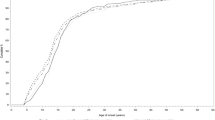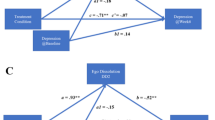Abstract
Objective The goals of this study are to provide estimates of clinical and demographic variables of patients with seasonal affective disorder (SAD) in Germany and Austria, to compare our results with those of previously published SAD studies, and to find out whether the clinical pattern of SAD remained stable over several years. Method We investigated 610 SAD patients from the outpatient clinics in Bonn (n = 190) and Vienna (n = 420). Patients in Bonn were recruited in the fall-winter season of the years 1989–1992, those in Vienna in the years 1993–2001. Results We observed a change in the clinical pattern in our patients: patients from Bonn, who were diagnosed and treated about 5 years earlier, were more likely to suffer from melancholic depression, whereas Viennese patients rather suffered from atypical depression (χ2 = 54.952, df = 2, p < 0.001). The symptoms of hypersomnia, daytime fatigue, increased eating and carbohydrate-craving were more frequent in the Viennese sample, anxiety and deterioration of patients' capacity to perform at work predominated in Bonn. In addition, patients from Vienna obtained a higher GSS (global seasonality score, measured by the SPAQ – Seasonal Pattern Assessment Questionnaire) than those from Bonn (15.7 ± 3.3 and 14.6 ± 4.1 respectively; t = 3.104, p = 0.002). Taken together, our results were in good accordance to other published SAD materials, but we were able to demonstrate that our patients reported “feeling worst” (measured by item 13H of the SPAQ) in November and December, whereas SAD patients in the USA clearly had their worst months in January and February. Conclusions We suggest that an increase in awareness of fall-winter depression in the last decade by both doctors, who referred patients, as well as patients or the entire population must have caused patients to sign up for light therapy at the Viennese SAD clinic because of having heard about the atypical symptom profile. This increased awareness of SAD can also be measured by a statistically significant reduction in the diagnostic latency (from the age of onset to the diagnosis of SAD) when comparing the two study locations.
Similar content being viewed by others
Author information
Authors and Affiliations
Additional information
Received: 23 October 2001 / Accepted: 20 February 2002
Rights and permissions
About this article
Cite this article
Winkler, D., Willeit, M., Praschak-Rieder, N. et al. Changes of clinical pattern in seasonal affective disorder (SAD) over time in a German-speaking sample. European Archives of Psychiatry and Clinical Neurosciences 252, 54–62 (2002). https://doi.org/10.1007/s004060200012
Published:
Issue Date:
DOI: https://doi.org/10.1007/s004060200012




